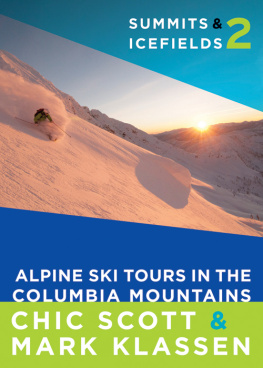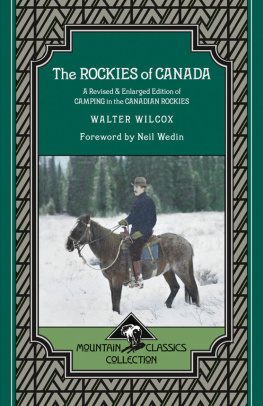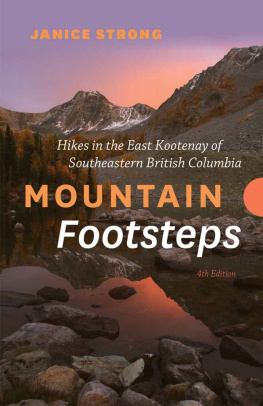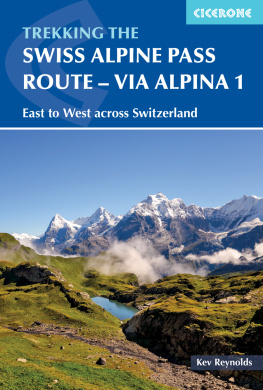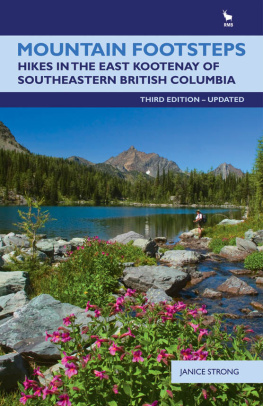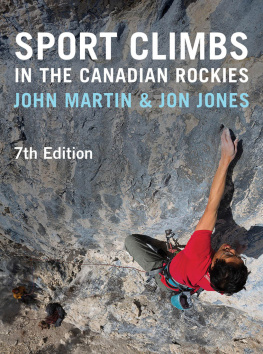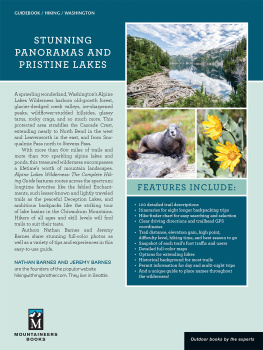ACKNOWLEDGEMENTS
The authors would like to thank all those who have helped create this new edition of Summits and Icefields, in particular Marg Saul, Sandra McGuinness, Ryan Bavin, Robin Tivy, Conor Hurley, Jim Firstbrook, Greg Hill, Stan Wagon, Doug Sproule, The Friends of Mount Revelstoke and Glacier National Parks, Canadian Mountain Holidays, Neills Kristensen, Howard Coneybear, Jacolyn Daniluck, Grant Statham, Aaron Beardmore, Jeff Volp, Jeff Hammerich, Ilya Storm, Karl Klassen, Grant Carnie, Sylvia Forest, Scott Davis, Peter Macpherson, Todd Anthony-Malone, Wayne Sobool, Marc Pich, Conrad Janzen and Chris Gooliaff.
A big thank you to all the staff at the Banff Public Library for providing such a warm and comfortable work space.
We would also like to thank those who have allowed us to use their fabulous images in the book. And we cannot forget the dozens of individuals who contributed to earlier editions of Summits and Icefields. Your excellent information and many of your photographs are still included in this new edition.
Major thanks is due to the folks at Rocky Mountain Books who put this beautiful guidebook together Don Gorman, Joe Wilderson and Chyla Cardinal. Its great to work with professionals.
And finally we must give a special thank you to Will Meinen, who created the new maps in this book. He certainly went the extra mile for this project. If you have any need of Wills expertise, he can be reached at wmcartography@gmail.com.
ALPINE SKI TOURING
IN THE CANADIAN
ROCKIES by Mark Klassen
This section is meant to help readers understand the unique nature of ski touring in the Columbia Mountains and what resources are available to help them plan their trips. It is assumed that users of this book have previous training and experience in ski touring and ski mountaineering.
A list of resources and contact information can be found .
HAZARDS
Hazards that may be new to skiers coming from other regions include the following:
Persistent weak layers in the snowpack These are unstable layers that continue to produce avalanches for days, weeks or months after they are buried. In the Columbia Mountains these PWLs are usually made up of surface hoar. In some years a crust and facet combination buried near the ground also causes issues that may last the entire season. When PWLs are in play within the snowpack, skiers in the Columbias must employ more conservative terrain selection than may be required at other times or in other snowpack climates. For many tours, patience is often required to wait for the right conditions or time of year.
Variable snow depths and layer distribution Wind may transport the regions low-density snow and cause windslabs days after a storm, resulting in highly variable avalanche hazard. Care must be taken when moving from one type of terrain to another.
Extreme cold Although temperatures are generally milder than those found farther east in the Rockies, temperatures in the -20 Celsius range are not uncommon. Equipment and clothing strategies must reflect the possibility of encountering very cold temperatures.
Weak crevasse bridges The glaciers in the region are active, and extensively crevassed areas are common. This, combined with a relatively low-density snowpack, means crevasse bridges may be both somewhat weak and hard to distinguish. Carrying and using a rope on the glaciers is common practice here.
Tree wells The low-hanging branches of small and medium-sized coniferous trees may prevent snow from packing in around the trunk of the tree, causing a deep, hidden hole to form. Falling headfirst into one of these holes can be as dangerous as getting buried in an avalanche. Fatal tree-well accidents occur almost every year in the Columbia Mountains. In the trees, ski in control and with a partner.
Short days On the winter solstice at Rogers Pass (about halfway between Nelson and Valemount), the sun rises at 7:53 a.m. and sets at 3:45 p.m. (Pacific Standard Time). On the spring equinox, daylight hours are significantly longer, with sunrise at 5:53 a.m. and sunset at 6:03 p.m. At this latitude, twilight begins and ends about half an hour either side of sunrise and sunset.
Remoteness Although more and more skiers are seen in the backcountry of the Columbias, it is not uncommon to have a tour to yourself where you will not see another party. On some of the multi-day trips you may not see anyone else for days at a time. Ski touring parties should be prepared to take care of themselves if any issues arise, as outside rescue resources can take some time to get to you, especially in bad weather. Carrying a communications device such as a satellite phone or personal locator beacon is recommended.
WHEN TO GO
The ski season in the Columbia Mountains can be long. Dedicated skiers often get their first turns in early November and continue skiing well into May. Some of the icefield tours and ski mountaineering ascents may be done into June if valley bottom travel is not required.
In most years there will be some good skiing available in most zones by late November and the season is normally in full swing by early to mid-December. Higher elevations with a smooth ground surface may have the earliest opportunities for skiing. Lower-elevation alder thickets can be difficult to travel through in many areas before Christmas.
January and February are the best powder skiing months. There is usually widespread good snow coverage by this time and temperatures remain cold, resulting in the blower pow that BC is famous for. The skiing continues to be outstanding through March, although suncrusts can be expected on solar aspects as the season progresses.
For many local skiers the spring is their favourite time to ski. By late March more serious tours may become practical because of longer days and better coverage on the glaciers. A significant warming event usually takes place sometime in mid- to late April, resulting in easier travel and a more stable snowpack. Often there will be a variety of ski options available in late April and early May, with corn snow on the solar aspects and powder on the north-facing slopes. This may be the time to do that committing traverse or ski mountaineering ascent youve had on your list all winter. Late-season touring in the Columbias is exceptional.
In seasons when PWLs are active, late February and March can be the trickiest times of the season. Layers that formed earlier in the winter often become the most reactive at this time, when they have a critical load of snow on them.
Every ski season is different and there are always exceptions to these broad rules. It is important for readers to practise proper pre-trip planning and investigation to find out where the safest and best skiing is at any given time.
GEOGRAPHY
The geography and toponymy of the Columbia Mountains are complicated. The region is actually a group of four separate mountain ranges: the Purcells, Selkirks, Monashees and Cariboos. These ranges are bounded by the Rocky Mountain Trench to the east, the Fraser River to the north, the edge of the Interior Plateau to the west and the US border to the south.
The Purcells lie in the southeast corner of the region, with the Rocky Mountain Trench (upper Columbia and Kootenay rivers) to the east. The Duncan and Beaver rivers separate the Purcells from the Selkirks to the west and north.
The Selkirks are in the centre of the range, with the Purcells to the east, the lower Columbia River to the west and the Monashees on the west side of the Columbia. The Selkirks northernmost reaches are surrounded by the Big Bend of the Columbia River.
The Monashees are west of the Selkirks and south of the Cariboos. The Interior Plateau lies to the southwest and the Columbia River to the east. The boundary to the northeast is Kinbasket Lake, and to the northwest it is Highway 5 between Kamloops and Valemount.

